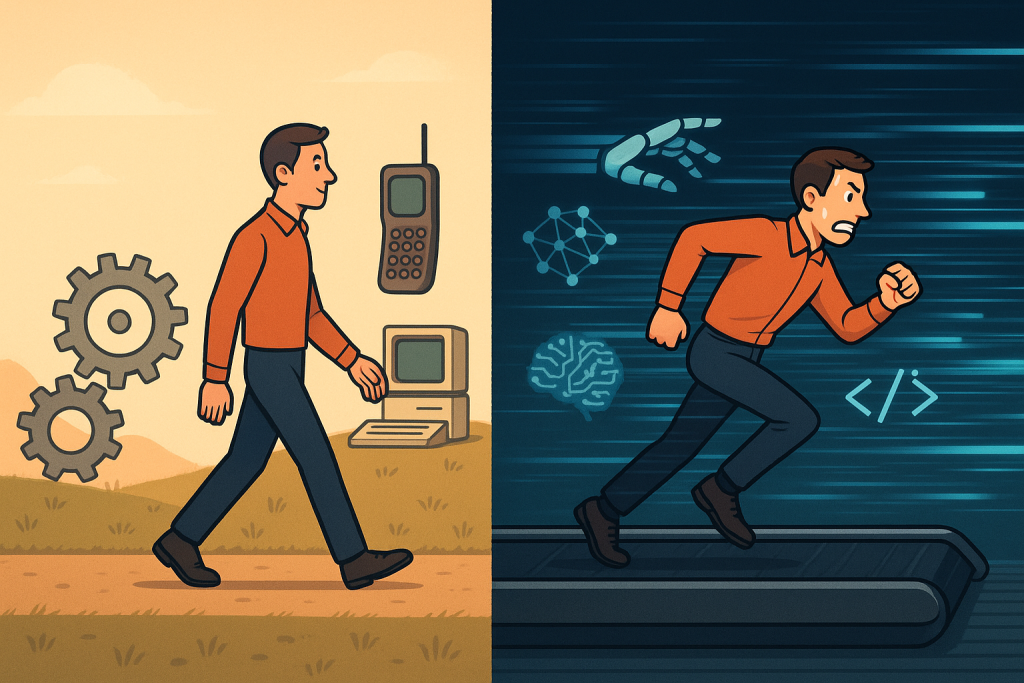A personal exploration of what it means to create when AI handles the execution

The Question That Stopped Me Cold
“Did you write your most recent white paper?”
My friend’s question yesterday was innocent enough, but it hit me like a brick wall. I found myself stumbling through an answer that felt both true and inadequate at the same time.
“Well, AI wrote it, but I…” I started, then stopped. “I mean, I used AI as a tool, but I spent hours…” Another pause. “It’s complicated.”
The conversation moved on, but the question lingered. Had I written the paper? In the most literal sense—fingers on keyboard, words appearing on screen—no, I hadn’t. But dismissing my role felt wrong too. I had spent hours in conversation with AI, bringing my critical thinking, life experience, and pattern recognition to bear on the content. I had shaped every argument, guided every direction, and made countless decisions about what belonged and what didn’t.
Later that evening, the right word finally came to me: I hadn’t written the paper. I had composed it.
Read the full whitepaper here:
https://avimaderer.com/the-experience-gap/
The Composer’s Role in the Age of AI
This distinction—between writing and composing—might seem semantic, but it’s actually profound. It points to a new form of creative collaboration that we’re all navigating but haven’t quite learned to articulate yet.
When a composer writes a symphony, they don’t physically play every instrument. They create the structure, choose the harmonies, guide the emotional arc, and make countless decisions about how ideas should flow together. The orchestra executes their vision, but no one questions who created the music.
Working with AI feels remarkably similar. I brought:
- The conceptual framework – What questions needed exploring?
- The narrative structure – How should ideas build on each other?
- Critical synthesis – Which connections matter and why?
- Experiential wisdom – What insights from my own life apply here?
- Editorial judgment – What serves the reader and what doesn’t?
AI handled the execution—the actual sentence construction, formatting, and technical writing mechanics. But every substantive choice was mine.
Beyond “Human in the Loop”
The current discourse around AI creativity often falls into two camps: either AI is doing everything (threat narrative) or humans are completely in control (reassurance narrative). Both miss the nuanced reality of genuine human-AI collaboration.
The phrase “human in the loop” suggests we’re just quality control—reviewing and approving AI’s work. But that’s not what happened with my white paper. I wasn’t in the loop; I was conducting the orchestra.
I was:
- Initiating every major direction
- Questioning assumptions and pushing for deeper thinking
- Connecting disparate ideas across domains
- Filtering through my values and experience
- Iterating toward a vision only I could see
This is composition, not editing. Creation, not curation.
A Framework for Creative Collaboration
If we’re going to navigate this new landscape of human-AI creativity, we need better language and clearer frameworks. Here’s how I’m starting to think about it:
Execution vs. Composition
Execution includes:
- Sentence construction and grammar
- Formatting and structure
- Research compilation
- Technical writing mechanics
- Style consistency
Composition includes:
- Conceptual framework development
- Narrative arc creation
- Critical analysis and synthesis
- Value-based filtering and judgment
- Creative direction and vision
The key insight: AI excels at execution but cannot compose without human intentionality, experience, and judgment.
The Four Pillars of AI-Assisted Composition
When I reflect on my white paper process, four distinct human contributions emerge:
- Vision Setting – What is this really about? What matters here?
- Connection Making – How do disparate ideas relate? What patterns exist?
- Experience Integration – What do I know from living that informs this?
- Value Filtering – What serves the reader? What aligns with my beliefs?
These capabilities remain uniquely human because they require lived experience, emotional intelligence, and the kind of contextual judgment that comes from being embedded in the world.
Practical Implications
This framework isn’t just philosophical—it has real implications for how we work, communicate, and understand our roles in an AI-enabled world.
For Professionals
When someone asks if you “wrote” something created with AI assistance, you can confidently say: “I composed it. AI handled the execution, but every substantive decision was mine.”
For Evaluating Creative Work
Instead of asking “Did a human write this?” we might ask: “Who provided the creative vision, made the connections, and exercised judgment about what matters?”
for Understanding Value
Your value as a creative professional isn’t in your typing speed or grammar skills—it’s in your ability to see patterns, make connections, integrate experience, and guide work toward meaningful outcomes.
The Bigger Picture
This shift from writing to composing reflects something larger happening across all creative fields. We’re moving from a world where human value came from executing tasks to one where it comes from creative direction, synthesis, and judgment.
The Bridge Generation—those of us navigating this transition—has a unique opportunity. We remember what pure human creation felt like, but we’re also learning to collaborate with AI in ways that amplify rather than replace our essential human capabilities.
The question isn’t whether AI will change how we create—it already has. The question is whether we can articulate and claim our evolving role as composers, conductors, and creative directors in this new landscape.
Moving Forward
I’m still learning to navigate these conversations about AI-assisted creation. But I’m getting more confident about claiming my role as a composer rather than apologizing for not being a traditional writer.
The next time someone asks if I wrote something, I’ll know exactly what to say: “I composed it through conversation with AI, bringing my experience, judgment, and vision to guide every substantive decision. AI was my instrument; I was the composer.”
That feels both honest and empowering. Most importantly, it feels true.
Read the full whitepaper here:
https://avimaderer.com/the-experience-gap/
What’s your experience with AI-assisted creativity? How do you describe your role when AI handles execution but you provide the vision and judgment? I’d love to hear how you’re navigating these questions.

